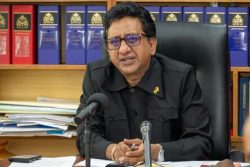Given the breadth of the illicit contact between the Ministry of Natural Resources and ExxonMobil’s subsidiary, EEPGL to ultimately deprive this country of oil profits, the government and those involved must be held fully accountable.
Readers should understand that the unapproved engagement between the ministry and EEPGL could have cost the country as much as US$105m in profits – roughly $21 billion in our currency. That is enough to take care of the basic needs of some of our pensioners and enough to put this government to shame and raise serious doubts about its stewardship of this country’s revenues and broader matters.
The scandal which the government would like to have disappear also underlines the importance of the press in a country where not enough recognition is accorded to its vital role. Were it not for Stabroek News’ disclosure of the IHS Markit audit report finding of US$214m in disputed expenses claimed by ExxonMobil and partners, the public would be none the wiser of how vigilant the country must be with accounting for oil revenues. Were it not for Stabroek News’ disclosure that the Guyana Revenue Authority (GRA) had finally agreed that the US$214m figure should remain as the contested amount, the public may never have known that a deal had been done to cut this to a measly US$3m.
So after coming under pressure from reports in Stabroek News, the government then set about trying to save its image. Through Vice President Jagdeo it was disclosed that President Ali had ordered a probe into the matter. The country waited. Eleven days on, Stabroek News editorialised last Monday on the complete blackout on information about this probe – who was conducting it and naturally the terms. On Thursday it became known that a report had been submitted to Cabinet and was being deliberated on with a decision to be taken. On Thursday night, a statement was issued by Minister of Natural Resources, Vickram Bharrat on a report that he had submitted and inevitably the questions mounted.
Declaring that he wanted to bring clarity to the matter, Minister Bharrat said from the inception of the audit examination the Government of Guyana’s position had always been that the GRA is the sole and final authority to determine the outcome in relation to the audit.
The Ministry’s role, he said, was to oversee the process of conducting the audit as well as to facilitate the exchange of information and documentation among the relevant parties, including the GRA.
He then went on to assign blame to the Senior Petroleum Coordinator in the Ministry, Gopnauth `Bobby’ Gossai.
“… based on advice from Mr. Gopnauth Gossai that the initial claim of USD$214,911,994 was reduced to USD$3,414,853.68, I wrote the Guyana Revenue Authority on 28th November, 2022 to confirm this figure by seeking a `No Objection’.
“As recent as July, 2023 Mr. Gossai in a meeting with the Vice President Bharrat Jagdeo and I, reported that the initial sum was reduced to USD$11,497,140 then further down to USD$3,414,853.68. Given that I had written the GRA since November, 2022 and it was established that the GRA’s involvement is necessary to finalize the audit, I was under the impression that the (reduced) figure was done in collaboration with the GRA”.
Minister Bharrat said that he subsequently learnt that the GRA had not agreed with the position and the initial claim of USD$214,911,994 stood.
“Therefore, after examining all the facts it is clear that Mr. Gossai acted without the requisite authorization to engage EEPGL and provided inadequate advice and as such, I have asked the Permanent Secretary to take the necessary disciplinary measures”, he stated.
This admission was breathtaking in the laxity that clearly pervaded the ministry and the blank canvas for corruption.
Minister Bharrat’s report can in no way be construed as constituting an independent examination of the facts. This is his side of the story and based on this alone he should have tendered his resignation as the minister on Thursday night or be dismissed. How could he have been so blissfully unaware of a subversive attempt to reduce profits due to this country? What culture prevails in this very important ministry that would permit such an egregious illegality?
Now that his report has been submitted the real investigation must begin and Minister Bharrat should also be a witness of interest. While an independent examination is awaited, there is enough information for the matter to be referred to the Special Organised Crime Unit (SOCU) and the Integrity Commission to determine if there has been any untoward conduct. This would naturally require questioning of Mr Gossai and an examination of the interface with ExxonMobil’s subsidiary. Who at this subsidiary interfaced with Mr Gossai at the ministry or with any other official with the intent to cut the disputed US$214m figure to very low gravy? SOCU should also be interested in speaking to them.
During the lengthy audit cycle, the UK firm IHS Markit was not presented with any evidence by EEPGL that convinced it to reduce the disputed figure of US$214m. It then issued its final report. Yet, in a completely unsanctioned process, Mr Gossai allegedly accepted some type of explanation to slash the US$214m figure to just US$3m. The public wants to see this paperwork or the entreaties that went with it. It must be quite convincing.
The public now expects to be told how the additional profit of US$107m will be reflected in this country’s accounts. Is it the Ministry of Finance or the Ministry of Natural Resources or the Office of the President that will take on the responsibility? That money belongs to the people and must be retrieved.
It is now left to be seen if the government will recognise the reputational damage that has occurred in relation to managing oil revenues and if it will commission a swift investigation of the circumstances.







